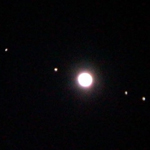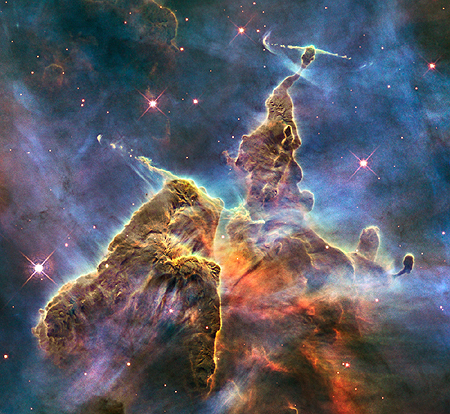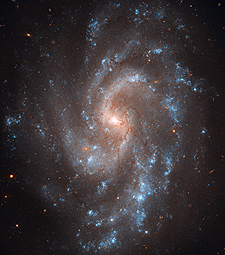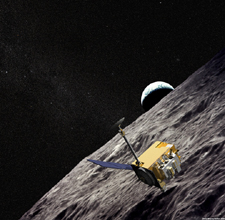You can get a good view of Venus, Jupiter, Mars and Saturn this month plus a nice meteor shower!
Venus dominates the night sky in January 2012. It’s the bright point of light you’ll see in the western sky during the early evening hours: It will be the brightest astronomical object you’ll see this month, other than the moon and the sun! Venus will appear higher and higher in the western sky as the month progresses. Venus begins the month in the constellation Capricorn and moves into Aquarius January 12.
Look for our solar system’s giant planet — Jupiter — toward the southern horizon (toward the northern horizon for those of you in the southern hemisphere) at sunset. Jupiter will pass very close to the Moon on the evening of January 2 (January 3 for those of you in Australia, New Zealand, Japan, China, etc.). The same thing will happen on the evening of January 29/30. You should be able to see Jupiter and up to four of its large moons through any telescope — even through a pair of binoculars. These four large moons move so quickly that if you observe Jupiter’s moons every few hours you’ll see that they change their position in relation to the planet. For example, if you observe Jupiter shortly after sunset you might see one or two of its large moons, but if you observe Jupiter a few hours later you might see all four of its large moons — or vice versa! Currently, Jupiter straddles the border between the constellations Aries and Pisces, but will move fully into Aries by month’s end.

Mars rises over the eastern horizon shortly after midnight this month, and is above the southern horizon shortly before sunrise (above the northern horizon for those of you in the southern hemisphere). If you are an early bird, look for the Red Planet near the Moon shortly before sunrise on January 13 and 14 (January 14 and 15 for those of you in the eastern hemisphere of Earth). The red planet begins the month in the Name A Star Live constellation Leo, but then moves into Virgo toward the end of the month.
You can see the beautiful, ringed planet Saturn in the eastern sky during the predawn hours in January. Saturn is in the constellation Virgo. On the morning of January 16 (January 17 for those of you in the eastern hemisphere) look for Saturn next to the Moon.
An Impressive Meteor Shower in Early January
The Quadrantid meteor shower promises to put on a good show of ‘shooting stars’ this month, but you’ll have to get up really early (or stay up really late!) to get the best view. Look for the shooting stars between about 3:00 a.m. and sunrise on January 4 (January 5 for those of you in Australia, Japan and China). Normally you can see about 120 meteors per hour at the peak of the Quadrantid’s, although you may see anywhere from only 60 to as much as 200 meteors per hour.

- Time lapse photo showing shooting stars from the Geminid meteor shower. Credit: NASA/JPL
A meteor shower occurs when the Earth passes through a cloud of dust particles, typically left from past visits by comets to our part of the solar system. As the high-speed dust particles vaporize in Earth’s atmosphere, they appear as ‘shooting stars.’ Meteor shower names derive from the constellation (the area of the night sky) from which the meteors appear to originate. The Quadrantid meteor shower gets its name from an old, and now defunct, constellation name (a name no longer used in astronomy) called “Quadrans Muralis”. This area of the night sky is now in the modern constellations Draco and Boötes, the latter of which is adjacent to the Name A Star Live constellation Virgo.
The best way to view a meteor shower is to lay down and look up: No telescopes or binoculars needed! You might use a fully reclining lawn chair or cot. Be prepared to stay up late to see the best show.
When to go stargazing this month
Moonlight ‘drowns out’ the faint light of many stars and other celestial objects, so the best time to view the stars is when the Moon is not visible. If you’re going to stargaze between sunset and midnight, then the best time to do that in January would be during the January 15-28 time period.
Finding your star in the night sky
Stars are located within constellations, which are just areas of the night sky. Scorpius, Aries and Taurus are examples of constellations. Your Name A Star Live Star Certificate displays the name of your constellation.
You can use our online World Constellation Guide to determine if you can see your constellation during the evening hours (between sunset and midnight). Of course, you’ll need a telescope to see your star. (That’s why we include the SLOOH online telescope experience in our Deluxe, Framed and Ultimate Gift Sets!) But you can see your constellation without the use of a telescope.
You can also find your constellation by using our Virtual Planetarium™ astronomy software. A planisphere is another useful device.
 As you’re thinking about what to get your friends and loved ones for Christmas and/or Hanukkah, you might be interested in some of the holiday messages Name A Star Live customers have included on their Star Certificates in recent weeks. Below are just some of the many holiday messages so far from the 2011 season. (Of course, we’ve changed the names in the messages to protect the privacy of our customers.)
As you’re thinking about what to get your friends and loved ones for Christmas and/or Hanukkah, you might be interested in some of the holiday messages Name A Star Live customers have included on their Star Certificates in recent weeks. Below are just some of the many holiday messages so far from the 2011 season. (Of course, we’ve changed the names in the messages to protect the privacy of our customers.)







